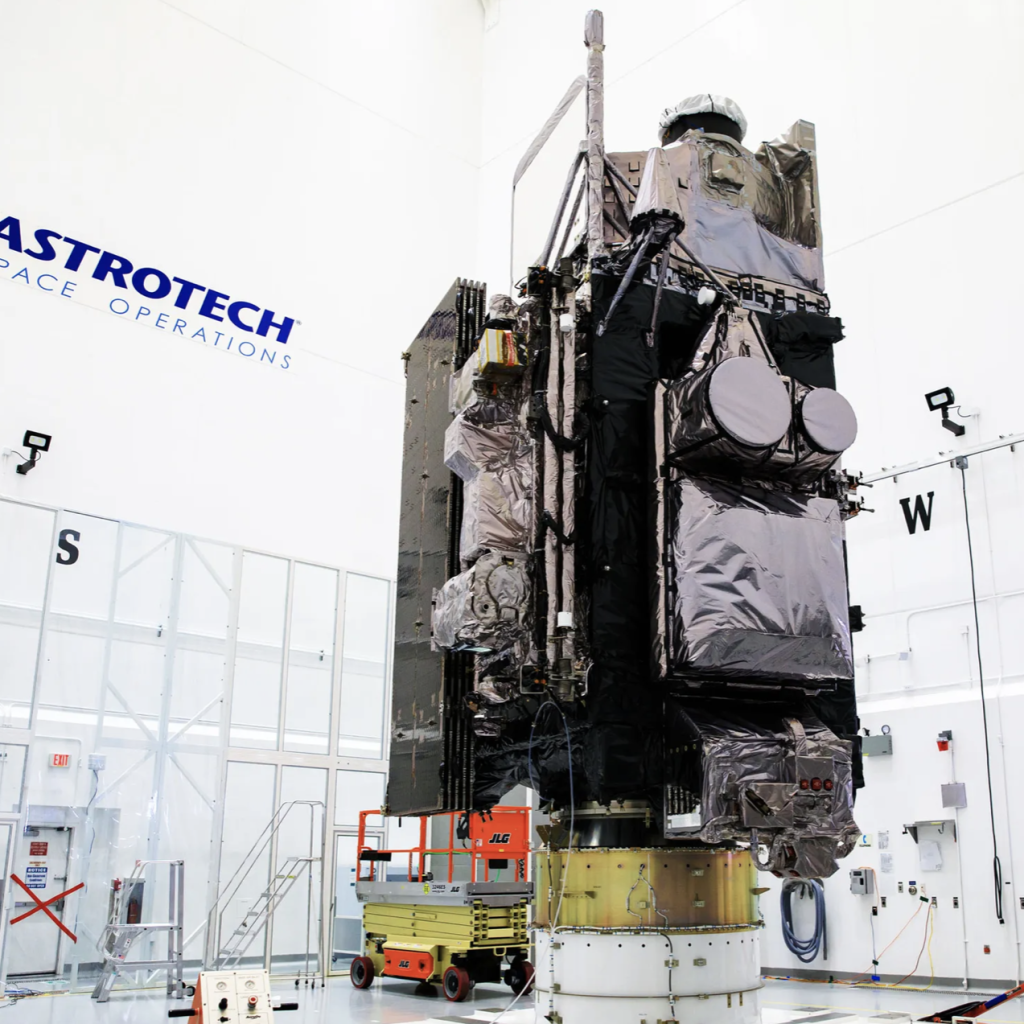Link About It: This Week’s Picks
A hydrogen-fueled train, an NFT fundraiser for Ukraine, oil-spill constellations and more from around the web

New Storm-Tracking Satellite Will Observe Space Weather Too
 Headed into space on 1 March, the GOES-T satellite and its arsenal of high-resolution cameras will track storms, wildfires and more in real time across North America. The National Atmospheric and Oceanic Administration (NAOA) partnered with NASA to design and construct the satellite, which already has siblings in space. In contrast to previous satellites of this nature, which mostly trek through low Earth orbit, GOES-T will rise up to 22,000 miles (“about a 10th of the way to the moon,” according to Wired). This will allow scientists to observe ozone as well as atmospheric phenomena and space weather. Read more about the tracking program and its retired satellites at Wired.
Headed into space on 1 March, the GOES-T satellite and its arsenal of high-resolution cameras will track storms, wildfires and more in real time across North America. The National Atmospheric and Oceanic Administration (NAOA) partnered with NASA to design and construct the satellite, which already has siblings in space. In contrast to previous satellites of this nature, which mostly trek through low Earth orbit, GOES-T will rise up to 22,000 miles (“about a 10th of the way to the moon,” according to Wired). This will allow scientists to observe ozone as well as atmospheric phenomena and space weather. Read more about the tracking program and its retired satellites at Wired.
Image courtesy of Kim Shiflett/NASA
Collective Bidding is Boosting The UkraineDAO 1/1 NFT Fundraiser
 Tech startup CXIP has minted a 1/1 NFT of the Ukrainian flag, with all proceeds from its sale going to Come Back Alive, an organization that will provide aid to Ukrainian civilians living in the middle of the war. CXIP launched the project as a collaboration with Pussy Riot, Trippy Labs, PleasrDAO and numerous Ukrainian humanitarian activists. The auction—which incorporates a feature that allows users to bid collectively and own a fraction of the NFT, thus increasing the overall amount raised for the charity—has amassed over 1,102 ETH (over $3 million) at the time of publish. Find out more at UkraineDAO.
Tech startup CXIP has minted a 1/1 NFT of the Ukrainian flag, with all proceeds from its sale going to Come Back Alive, an organization that will provide aid to Ukrainian civilians living in the middle of the war. CXIP launched the project as a collaboration with Pussy Riot, Trippy Labs, PleasrDAO and numerous Ukrainian humanitarian activists. The auction—which incorporates a feature that allows users to bid collectively and own a fraction of the NFT, thus increasing the overall amount raised for the charity—has amassed over 1,102 ETH (over $3 million) at the time of publish. Find out more at UkraineDAO.
Image courtesy of UkraineDAO
A Smart Walking Companion That Transforms Mobility
 While conventional walking canes often lack thoughtful design and still require strain on the part of those using it, the Stride Senze—an intelligent walking companion—is sleek, modern and equipped with smart technology to ensure the safety of users. Created by the Singapore-based NextOfKin, the cane features sensors that scan the area to help navigate spaces; smart technology to monitor the user’s gait, balance and mobility; self-balancing aids for better weight support and fall-detection which alerts social services or family in case of emergencies. Blending futuristic design and technological upgrades, the Stride Senze (which comes in either single support or walker mode) seeks to be a tool for empowerment. Learn more about it at designboom.
While conventional walking canes often lack thoughtful design and still require strain on the part of those using it, the Stride Senze—an intelligent walking companion—is sleek, modern and equipped with smart technology to ensure the safety of users. Created by the Singapore-based NextOfKin, the cane features sensors that scan the area to help navigate spaces; smart technology to monitor the user’s gait, balance and mobility; self-balancing aids for better weight support and fall-detection which alerts social services or family in case of emergencies. Blending futuristic design and technological upgrades, the Stride Senze (which comes in either single support or walker mode) seeks to be a tool for empowerment. Learn more about it at designboom.
Image courtesy of NextOfKin
Japan’s First Hydrogen Train Begins Its Test Run
 Developed by East Japan Railway Co, in partnership with Toyota Motor Corporation and Hitachi Ltd, Japan’s first hydrogen-fueled train is slated to begin trial testing next month—a plan that’s on track to assist the country in achieving its 2050 carbon-neutrality goal. The vehicle, a two-car “hybari” train (which combines the word hybrid with the Japanese word for lark), can travel up to 140 kilometers at a top speed of 100km/h on a single filling of hydrogen. This is just one of the ways Japan has aimed to make hydrogen a prime, clean energy source. Fuel-cell buses and commercial vehicles are already in use, and Toyota is striving to increase production of their hydrogen-fueled Mirai. Read more about the nation’s quest to be more sustainable and how hydrogen-fueled vehicles can play an integral role at Bloomberg.
Developed by East Japan Railway Co, in partnership with Toyota Motor Corporation and Hitachi Ltd, Japan’s first hydrogen-fueled train is slated to begin trial testing next month—a plan that’s on track to assist the country in achieving its 2050 carbon-neutrality goal. The vehicle, a two-car “hybari” train (which combines the word hybrid with the Japanese word for lark), can travel up to 140 kilometers at a top speed of 100km/h on a single filling of hydrogen. This is just one of the ways Japan has aimed to make hydrogen a prime, clean energy source. Fuel-cell buses and commercial vehicles are already in use, and Toyota is striving to increase production of their hydrogen-fueled Mirai. Read more about the nation’s quest to be more sustainable and how hydrogen-fueled vehicles can play an integral role at Bloomberg.
Image courtesy of JR East
Juha Tanhua’s Photography Turns Parking Lot Oil Spills Into Galaxies
 Finnish photographer Juha Tanhua noticed an oil spill by his car that reminded him of the Northern Lights. He captured it, then forgot about it. When he rediscovered the image in his archive, he began to seek out and photograph more leaks around parking lots after heavy rain. Tanhua soon amassed a collection—which he refers to as “oil paintings,” since they are quite literally artworks of oil—that he manipulates by playing with exposure, shadows, highlights and contrast to turn the spills into galaxies, nebulas, comets and other cosmic constellations. “I don’t look up, but down,” the artist explains to Colossal. “It’s not space above us; it’s space under our feet. You can find subjects to photograph even in dull places like parking lots. Expect nothing, get everything.” Learn more about Tanhua and view his mesmerizing photos at Colossal.
Finnish photographer Juha Tanhua noticed an oil spill by his car that reminded him of the Northern Lights. He captured it, then forgot about it. When he rediscovered the image in his archive, he began to seek out and photograph more leaks around parking lots after heavy rain. Tanhua soon amassed a collection—which he refers to as “oil paintings,” since they are quite literally artworks of oil—that he manipulates by playing with exposure, shadows, highlights and contrast to turn the spills into galaxies, nebulas, comets and other cosmic constellations. “I don’t look up, but down,” the artist explains to Colossal. “It’s not space above us; it’s space under our feet. You can find subjects to photograph even in dull places like parking lots. Expect nothing, get everything.” Learn more about Tanhua and view his mesmerizing photos at Colossal.
Image courtesy of Juha Tanhua
The Outsider Art Fair Opens its 30th Anniversary Edition in NYC
 From 3-6 March, the 30th anniversary edition of the Outsider Art Fair welcomes guests to Manhattan’s Metropolitan Pavilion. There, an astounding array of international exhibitors present art brut as well as the work of self-taught artists. Once again, the fair demonstrates that it is unlike any other through the range of complex artistry on hand to the powerful programming in its Curated Spaces sector (which includes a study on psychedelic art entitled “Field Trip: Psychedelic Solution, 1986–1995”). Learn more about this year’s diverse roster at the Outsider Art Fair website, or visit their Artland-powered online viewing rooms now.
From 3-6 March, the 30th anniversary edition of the Outsider Art Fair welcomes guests to Manhattan’s Metropolitan Pavilion. There, an astounding array of international exhibitors present art brut as well as the work of self-taught artists. Once again, the fair demonstrates that it is unlike any other through the range of complex artistry on hand to the powerful programming in its Curated Spaces sector (which includes a study on psychedelic art entitled “Field Trip: Psychedelic Solution, 1986–1995”). Learn more about this year’s diverse roster at the Outsider Art Fair website, or visit their Artland-powered online viewing rooms now.
Image courtesy of Elisabetta Zangrandi and James Barron Art
“Say No to War” Collection of Free Images
 Ukraine-based image-sharing platform Depositphotos has launched a free-to-use collection of photos called “Say No to War,” which depicts the “brutal truth of what’s happening in Ukraine, as well as images of protests from around the world and inside of Russia.” Some of the images are tremendously hopeful, while others are graphic and devastating. Crucially, they are real images by “regular” people. The photos are from existing Depositphotos contributors, but the team has made a call for new photographers to capture similar images with the intention of spreading the truth and combating propaganda. Find out more at It’s Nice That.
Ukraine-based image-sharing platform Depositphotos has launched a free-to-use collection of photos called “Say No to War,” which depicts the “brutal truth of what’s happening in Ukraine, as well as images of protests from around the world and inside of Russia.” Some of the images are tremendously hopeful, while others are graphic and devastating. Crucially, they are real images by “regular” people. The photos are from existing Depositphotos contributors, but the team has made a call for new photographers to capture similar images with the intention of spreading the truth and combating propaganda. Find out more at It’s Nice That.
Image: Helsinki, Finland, February 26, 2022: Demonstration against the Russian aggression in Ukraine, courtesy of karavanov/Depositphotos
AFAR’s Favorite Podcasts by Black Creatives
 The world of podcasts might be rife with true crime and the ramblings of white, heterosexual, cisgender men; but there are also plenty of gems out there. AFAR has rounded up 15 excellent podcasts that are helmed by Black creators and while some were already CH favorites, a few were lesser-known. From a show about travel for Black women to one about life inside the prison system (and what happens after) to deep dives on music and beyond, there’s plenty of information and inspiration to be found—and all told by dynamic hosts. Read the full list at AFAR.
The world of podcasts might be rife with true crime and the ramblings of white, heterosexual, cisgender men; but there are also plenty of gems out there. AFAR has rounded up 15 excellent podcasts that are helmed by Black creators and while some were already CH favorites, a few were lesser-known. From a show about travel for Black women to one about life inside the prison system (and what happens after) to deep dives on music and beyond, there’s plenty of information and inspiration to be found—and all told by dynamic hosts. Read the full list at AFAR.
Image courtesy of Ear Hustle/Radiotopia
150-Year-Old Chess Puzzle Solved
 A mathematician from Harvard University named Michael Simkin has (basically) solved the n queens problem, a chess puzzle that’s some 150 years old. The mathematical challenge was created by chess composer Max Bezzel in 1848 and essentially asks “How many queens can you place on a chess board so that none are attacking each other?” Using complex linear algebra, the puzzle has been solved for up to 27 queens, but beyond that mathematicians have been stumped. As Caroline Delbert writes for Popular Mechanics, “Consider this: for eight queens, there are just 92 solutions, but for 27 queens, there are over 200 quadrillion solutions. It’s easy to see how solving the problem for numbers higher than 27 becomes extremely unwieldy or even impossible without more computing power than we have at the moment.” Simkin outlines his solution across 50 pages in a self-published research paper and although it offers an estimate, it’s impressive none-the-less. Read more about this breakthrough at Popular Mechanics.
A mathematician from Harvard University named Michael Simkin has (basically) solved the n queens problem, a chess puzzle that’s some 150 years old. The mathematical challenge was created by chess composer Max Bezzel in 1848 and essentially asks “How many queens can you place on a chess board so that none are attacking each other?” Using complex linear algebra, the puzzle has been solved for up to 27 queens, but beyond that mathematicians have been stumped. As Caroline Delbert writes for Popular Mechanics, “Consider this: for eight queens, there are just 92 solutions, but for 27 queens, there are over 200 quadrillion solutions. It’s easy to see how solving the problem for numbers higher than 27 becomes extremely unwieldy or even impossible without more computing power than we have at the moment.” Simkin outlines his solution across 50 pages in a self-published research paper and although it offers an estimate, it’s impressive none-the-less. Read more about this breakthrough at Popular Mechanics.
Image courtesy of sk/Pexels
Abolishing the Fat Villain Stereotype in Pop Culture
 From Jabba The Hutt to Harry Potter’s uncle Vernon, fat villains permeate pop culture, sustaining real-life biases that demean and dismiss fat people. It’s a trope that, Sarah Stark writes for Inverse, needs to be abolished. While making fat people out to be lacking morals or inherently bad (a fat body symbolizes “evidence of sin,” according to Canadian sociologist Fiona Whittington-Walsh), the entertainment industry’s reliance on fat suits is also problematic. As comedian Guy Branum says, “The fat suit is such a fascinating way of saying that this character is not human. It is hard to be simultaneously told, ‘There are no parts that are right for you in Hollywood,’ and then have somebody put on a costume to look like me.” But in creating more positive fat characters—or simply writing them like any other character—”researchers and creators agree the solution is more and better fat representation.” Read the deep dive on fatphobia in pop culture at Inverse.
From Jabba The Hutt to Harry Potter’s uncle Vernon, fat villains permeate pop culture, sustaining real-life biases that demean and dismiss fat people. It’s a trope that, Sarah Stark writes for Inverse, needs to be abolished. While making fat people out to be lacking morals or inherently bad (a fat body symbolizes “evidence of sin,” according to Canadian sociologist Fiona Whittington-Walsh), the entertainment industry’s reliance on fat suits is also problematic. As comedian Guy Branum says, “The fat suit is such a fascinating way of saying that this character is not human. It is hard to be simultaneously told, ‘There are no parts that are right for you in Hollywood,’ and then have somebody put on a costume to look like me.” But in creating more positive fat characters—or simply writing them like any other character—”researchers and creators agree the solution is more and better fat representation.” Read the deep dive on fatphobia in pop culture at Inverse.
Link About It is our filtered look at the web, shared daily in Link and on social media, and rounded up every Saturday morning. Hero image courtesy of Juha Tanhua











